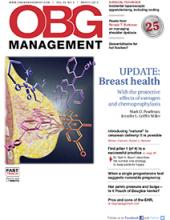“MOTHER-, BABY-, AND FAMILY-CENTERED CESAREAN DELIVERY:
IT IS POSSIBLE”
WILLIAM CAMANN, MD, AND ROBERT L. BARBIERI, MD (EDITORIAL; MARCH 2013)
Fathers can participate in skin-to-skin cesarean, too
I read about skin-to-skin cesarean delivery with great interest. I’d like to make a suggestion using a term coined by a physician whose wife required a cesarean: skin to win. The physician shared his wife’s disappointment when their obstetrician decided it would be wise to forego vaginal delivery in favor of cesarean. Because skin-to-skin was not offered at the hospital, the husband volunteered his skin. Since that occasion, I offer father-to-neonate “skin to win” as a general practice.
I have found this service to be incredibly rewarding for the father, and the mother is protected from feeling overwhelmed, worrying about dropping the baby, battling nausea and vomiting, and so on.
I must admit I never conceived of this possibility before. Now I tell all of my families about the smart fellow who coined the term.
T. M. Gordon, MD
Toledo, Ohio
Patient-centered cesarean is fraught with risks
I read with interest the article on so-called family-centered cesarean delivery. While no one would argue the point that the cesarean delivery procedure ultimately culminates in a happy outcome in a majority of cases, I have some very deep concerns.
The first involves the concept of early bonding, in which the newborn infant is placed on the mother’s chest immediately after delivery while the maternal abdomen is still open. In my opinion, this practice is fraught with risks, most important among them the substantial risk of contamination of the operative field. Lest we forget, although cesarean delivery is generally a happy occasion, it is still a laparotomy during which there is a risk of hemorrhage and the possible need for an abrupt shift in the care plan. While the operation is ongoing, the entire focus of the surgeon and the anesthesiologist or certified registered nurse anesthetist should be the mother, with the infant left to the care of the neonatal staff for assessment and transition.
I disagree with Dr. Camann and Dr. Barbieri that early bonding is easily achievable. I would assert that it is difficult, if not impossible, to accomplish with the newborn juxtaposed to the field and with additional people crowding the anesthesiologist’s working area. There is also the risk of contamination I mentioned earlier, which, once it occurs, poses a significant risk of unwarranted morbidity or even death.
The notion of breastfeeding on the operating table, in the middle of a major open surgical procedure, is even more ludicrous and dangerous. I know very few anesthesiologists in today’s litigious environment who would ever entertain this type of cesarean as an option in the surgical suite. The closing of the procedure generally can be completed in a matter of a few minutes by a competent surgeon, after which there is ample time for bonding and for family time in a much safer venue.
That said, there are some aspects of the article that could be adopted without jeopardizing the safety of the surgery itself. At the end of the day, however, the notion of “feel-good, touchy-feely” can be carried to an extreme. This article is one example. As surgeons, we have a sacred duty to protect our patients from unnecessary risk. It is my opinion that parts of the practice described in this editorial would violate that duty if employed as described.
Timothy E. Hughes, MD
Mobile, Alabama
Dr. Barbieri responds
Dr. Gordon’s patient has coined an elegant tagline to describe one of the goals of family-centered cesarean practices: “skin to win.” I thank Dr. Gordon for sharing it.
Dr. Hughes raises the important concerns that family-centered cesarean practices may result in contamination of the surgical field, crowding at the head of the table, and divert the surgeon’s attention from the important task of safely completing the operation. I agree that early skin-to-skin contact and breastfeeding in the operating room may require an additional nurse to ensure the safety of the baby and mother.
In my practice, two clinical variables raise my concern about postoperative infection: a long labor with ruptured membranes and an obese mother. More data are needed, but I doubt that family-centered delivery practices will increase the risk of postoperative infection.
We want to hear from you! Tell us what you think.


